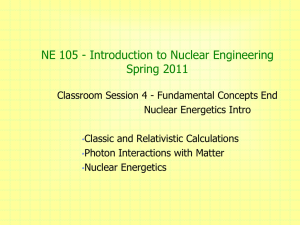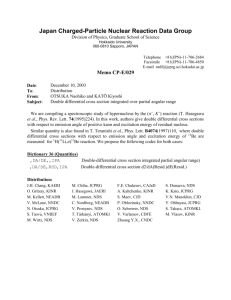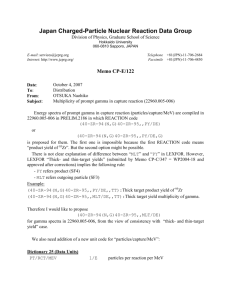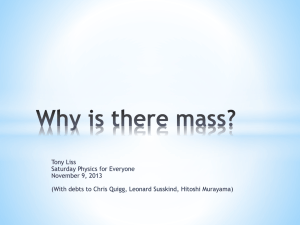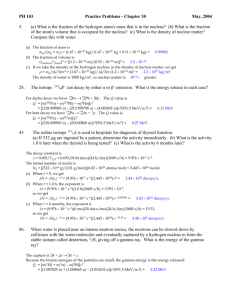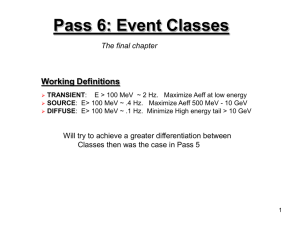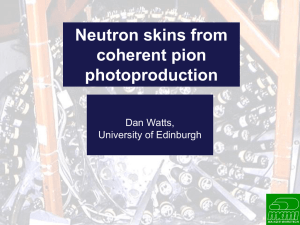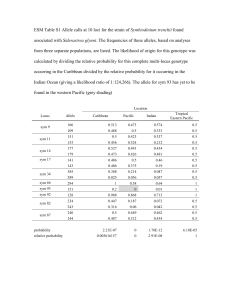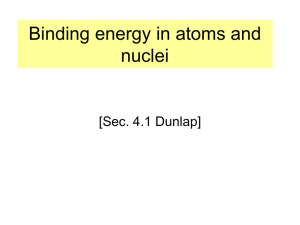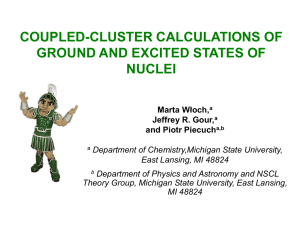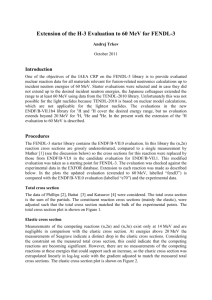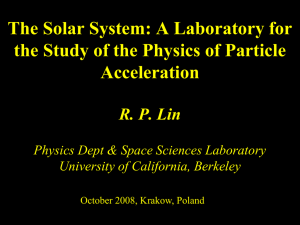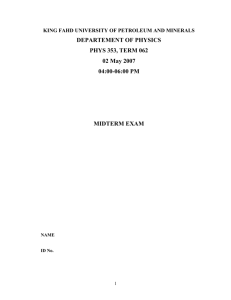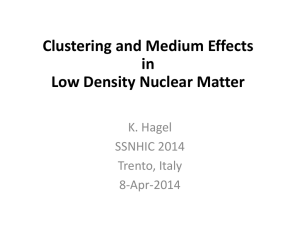HIMAC Pion Experiment and Pb Isotope Radius Measurements
advertisement
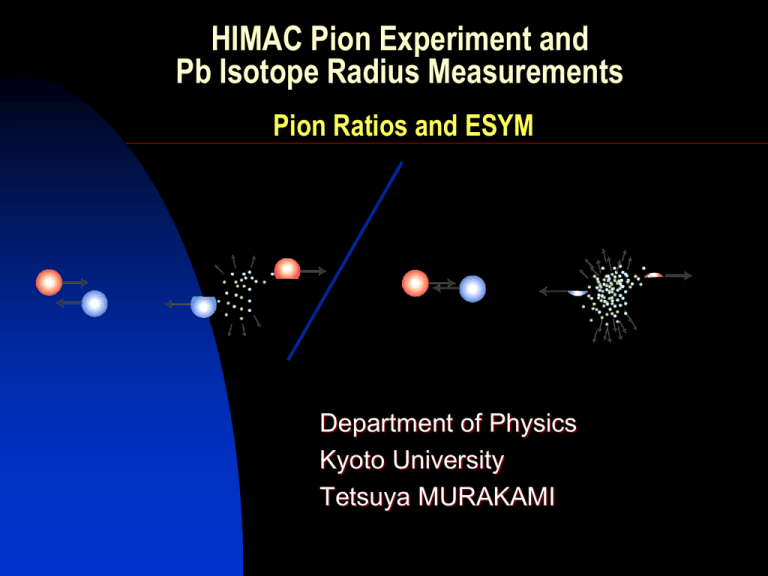
HIMAC Pion Experiment and Pb Isotope Radius Measurements Pion Ratios and ESYM Department of Physics Kyoto University Tetsuya MURAKAMI Neutron Star vs Nuclear EOS Mass High Density Mass Limit Observations of Mass and Radius Phase Transition Tolman–Oppenheimer–Volkoff equation Low Density Radius MR(Mass-Radius) Relation TOV equation EOS E/A Low Density (nucleon,electron,μ) High Density (nucleon,hyperon, meson,quark) L ρ0 Phase Transition 2ρ0 Density (ρB) Useful Notations E ( , ) E ( , 0 ) E sym ( ) E ( ,0 ) E ( 0 ,0 ) K0 2 ( ) 4 ( ) 2 3 2 E sym ( ) E sym ( 0 ) L K sym ( ) 2 3 2 E ( ,0 ) 2 K0 9 2 0 2 0 (n p ) / ( 0 ) / 3 0 S E sym ( 0 ) L 3 0 E sym ( ) 0 E sym ( ) 2 K sym 9 2 0 K K sym 6 L 2 0 3 It started in 2000 from Alex`s paper, PRL85, 5296 (2000) He urged experimentalists to measure a neutron skin thickness of 208Pb precisely. We challenge to ALEX and PREX. 4 Neutron Density Distributions of Pb Isotopes From J. Zenihiro’s PhD thesis 2011 PRC82, 054607 (2010) 5 RCNP, Osaka University Polarized Proton beams of 295 MeV Typical polarization ~75% 6 7 Analysis Relativistic Impulse Approximation developed by Murdock and Horowittz (MH) Realistic point proton density distribution deduced from electron scattering data Scalar density = 0.96 Vector density Neutron density = Sum of Gaussian 8 9 10 11 rnp ( fm ) 204 Pb 0 . 178 0 . 047 0 . 059 206 Pb 0 . 180 0 . 048 0 . 064 208 Pb 0 . 211 0 .063 0 . 054 12 13 S=33.0±1.1 MeV L=67.0±12.1 MeV 14 Li et al.(2009) 15 Summary of neutron skin thickness rnp ( fm ) 204 Pb 0 . 178 0 . 047 0 . 059 0 . 048 0 . 064 206 Pb 0 . 180 208 Pb 0 . 211 0 .063 S=33.0±1.1 MeV L=67.0±12.1 MeV 0 . 054 Unfortunately, doesn`t look like sufficiently precise. 16 ESPRI (Elastic Scattering of Proton with RI beam) Project One of Future Directions •Beam line MWDCs •Solid hydrogen target (1mm thick) •Large MWDCs for recoil protons •Array of 14 NaI(Tl) •Array of Silicon Strip Detectors We have measured elastic scatterings on 20O, 9-11C, and 66,70Ni. 17 According to Bao-An’s calculation from NPA 708 (2002) 365. 18 19 RIBF ? MSU GSI S=33.0±1.1 MeV L=67.0±12.1 MeV Ksym=-148±124 MeV Pion production Xiao, et al., arXiv:0808.0186 (2008) Reisdorf, et al., NPA 781 (2007) 459. Au+Au Isospin diffusion, n-p flow HIMAC Pion Experiments Details will be presented by Mr. Sako tomorrow. Our on-going SAMURAI-TPC project along the same direction will be presented by Dr. Isobe this afternoon. 21 Using Minimum Setup Centrality Filter Multiplicity filter for Charged Particles Portable, If possible. Pion Detector Simple and portable system HIMAC Performed Experiments Target Beam energy 30deg 45deg 60deg 75deg 90deg 120deg 2008.11 In (Pb) 132Xe 400 MeV/u ○ ○ ○ ○ 2009.7 In (Pb) 28Si 400 MeV/u ○ ○ ○ ○ ○ 2009.10 In (Pb) 28Si 600 MeV/u ○ ○ ○ ○ ○ ○ 2009.11 In 28Si 800 MeV/u ○ ○ ○ ○ ○ ○ Beam Energy Dependence : Si 600 MeV log scale π-/π+ Fitting : C*X π-/π+ -a log scale log scale π-/π+ 400 MeV 800 MeV slope α: • 400 : (4.5±0.5)×10-1 • 600 : (3.2±0.5)×10-1 • 800 : (2.0±0.5)×10-1 ● 45deg ■ 60deg ▼ 90deg ○ 120deg Slopes depend on Beam Energy Erapπ If we are lucky, we are going to measure pions from 129,132,136Xe on CsI reactions at 400 MeV/u in FY2011. Please come back for Mr. Sako‘s talk Thank you 25 Members of Collaboration RCNP E248 Collaboration Kyoto University J. Zenihiro, Y. Iwao, H. Sakaguchi, S. Terashima, Y. Yasuda, M. Yosoi Research Center for Nuclear Physics M. Itoh, M. Uchida, H.P. Yoshida HIMAC P226 Collaboration Kyoto University M. Sako, S. Ebesu, Y. Ichikawa, S. Imajo, R. Sameshima Rikkyo University K. Ieki, Y. Ikeda, H. Kawamura, M. Matsushita, J. Murata, M. Nitta, T. Toyoda RIKEN Nishina Center Y. Nakai, S. Nishimura NIRS E. Takada, 26



